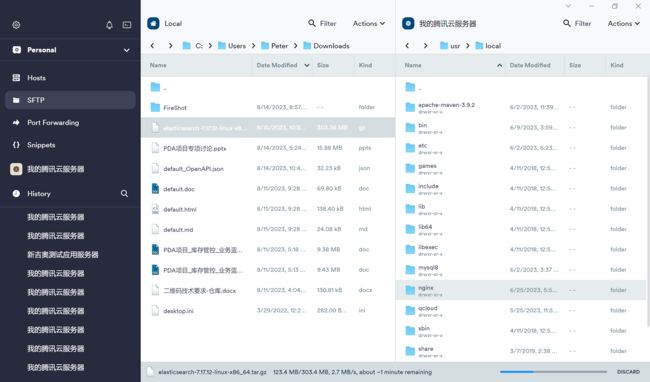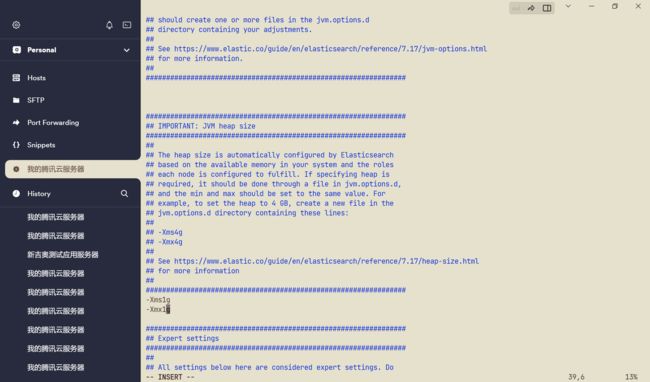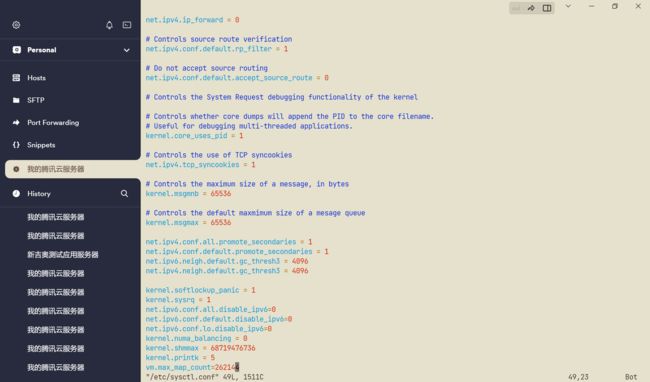CentOS系统环境搭建(十二)——CentOS7安装Elasticsearch
centos系统环境搭建专栏点击跳转
CentOS 7.9安装Elasticsearch 7.17.6
文章目录
- CentOS 7.9安装Elasticsearch 7.17.6
-
- 1.下载
- 2.上传
- 3.解压
- 4.调整es占用内存
- 5.修改elasticsearch配置文件
- 6.创建用户
- 7.Elasticsearch 后台启动与关闭
- 8.es管理脚本
-
- 8.1 关闭elasticsearch
- 8.2 启动elasticsearch
1.下载
https://www.elastic.co/downloads/past-releases/elasticsearch-7-17-6
若你是centos64位服务器,下载LINUX X86_64,下载后上传到linux服务器。
2.上传
上传至/usr/local/
3.解压
进入/usr/local/
cd /usr/local/
执行解压
tar -zxvf elasticsearch-7.17.6-linux-x86_64.tar.gz
4.调整es占用内存
若你电脑性能强劲,这个应该可以不改。
vim /usr/local/elasticsearch-7.17.6/config/jvm.options
修改为1g内存占用。
5.修改elasticsearch配置文件
编辑elasticsearch.yml
vim /usr/local/elasticsearch-7.17.6/config/elasticsearch.yml
设置节点名称
node.name: node-1
集群名
cluster.name: my-application
设置master节点列表
cluster.initial_master_nodes: ["node-1"]
端口
http.port: 9200
允许远程访问
network.host: 0.0.0.0
6.创建用户
elasticsearch默认不允许以root账号运行
创建用户
useradd es
设置密码
passwd es
创建所属组
chown es:es -R /usr/local/elasticsearch-7.17.6
增大es用户拥有的内存权限
vim /etc/sysctl.conf
在最后一行添加如下
vm.max_map_count=262144
sysctl -p
切换到es用户
su es
启动elasticsearch
cd /usr/local/elasticsearch-7.17.6/bin
./elasticsearch
7.Elasticsearch 后台启动与关闭
切换为es用户
su es
后台启动(重启)
sh /usr/local/elasticsearch-7.17.6/bin/elasticsearch -d
查看进程
ps aux | grep elasticsearch
执行后会看到如下
[es@VM-4-17-centos logs]$ ps aux | grep elasticsearch
es 31876 181 34.7 3856940 1312716 pts/0 Sl 11:52 0:27 /usr/local/elasticsearch-7.17.6/jdk/bin/java -Xshare:auto -Des.networkaddress.cache.ttl=60 -Des.networkaddress.cache.negative.ttl=10 -XX:+AlwaysPreTouch -Xss1m -Djava.awt.headless=true -Dfile.encoding=UTF-8 -Djna.nosys=true -XX:-OmitStackTraceInFastThrow -XX:+ShowCodeDetailsInExceptionMessages -Dio.netty.noUnsafe=true -Dio.netty.noKeySetOptimization=true -Dio.netty.recycler.maxCapacityPerThread=0 -Dio.netty.allocator.numDirectArenas=0 -Dlog4j.shutdownHookEnabled=false -Dlog4j2.disable.jmx=true -Dlog4j2.formatMsgNoLookups=true -Djava.locale.providers=SPI,COMPAT --add-opens=java.base/java.io=ALL-UNNAMED -Djava.security.manager=allow -Xms1g -Xmx1g -XX:+UseG1GC -Djava.io.tmpdir=/tmp/elasticsearch-185143932475254405 -XX:+HeapDumpOnOutOfMemoryError -XX:+ExitOnOutOfMemoryError -XX:HeapDumpPath=data -XX:ErrorFile=logs/hs_err_pid%p.log -Xlog:gc*,gc+age=trace,safepoint:file=logs/gc.log:utctime,pid,tags:filecount=32,filesize=64m -XX:MaxDirectMemorySize=536870912 -XX:G1HeapRegionSize=4m -XX:InitiatingHeapOccupancyPercent=30 -XX:G1ReservePercent=15 -Des.path.home=/usr/local/elasticsearch-7.17.6 -Des.path.conf=/usr/local/elasticsearch-7.17.6/config -Des.distribution.flavor=default -Des.distribution.type=tar -Des.bundled_jdk=true -cp /usr/local/elasticsearch-7.17.6/lib/* org.elasticsearch.bootstrap.Elasticsearch -d
es 31899 0.0 0.1 54520 4448 pts/0 Sl 11:52 0:00 /usr/local/elasticsearch-7.17.6/modules/x-pack-ml/platform/linux-x86_64/bin/controller
es 31983 0.0 0.0 112812 984 pts/0 S+ 11:52 0:00 grep --color=auto elasticsearch
关闭(杀死端口)
kill 31876 31899
查看日志
tail -f /usr/local/elasticsearch-7.17.6/logs/my-application.log
8.es管理脚本
但是这样仍然让我感到麻烦,es的今后的各种配置伴随要做大量的重启工作,我决心创建一个脚本,帮我完成这些复杂的事情。
8.1 关闭elasticsearch
脚本名称killes.sh,放到/usr/local/elasticsearch-7.17.6/bin/下。
#!/bin/bash
# 获取Elasticsearch进程ID列表
es_pids=$(ps -ef | grep elasticsearch | grep -v grep | awk '{print $2}')
# 逐个杀死Elasticsearch进程
for pid in $es_pids; do
kill $pid
done
为脚本添加执行权限
chmod +x /usr/local/elasticsearch-7.17.6/bin/killes.sh
关闭elasticsearch
cd /usr/local/elasticsearch-7.17.6/bin
./killes.sh
8.2 启动elasticsearch
su es
sh /usr/local/elasticsearch-7.17.6/bin/elasticsearch -d


